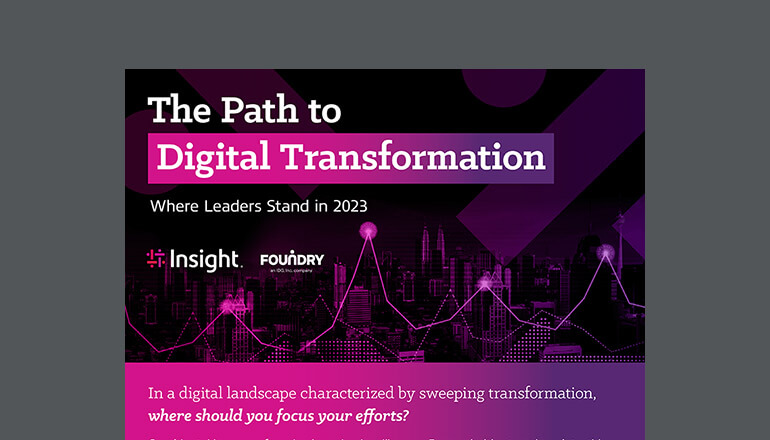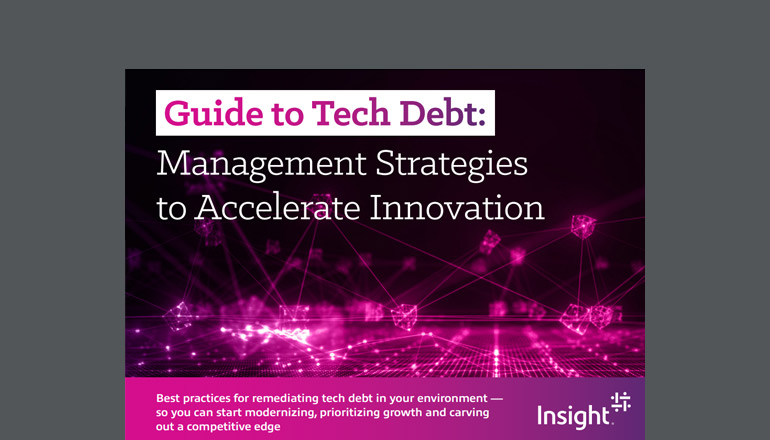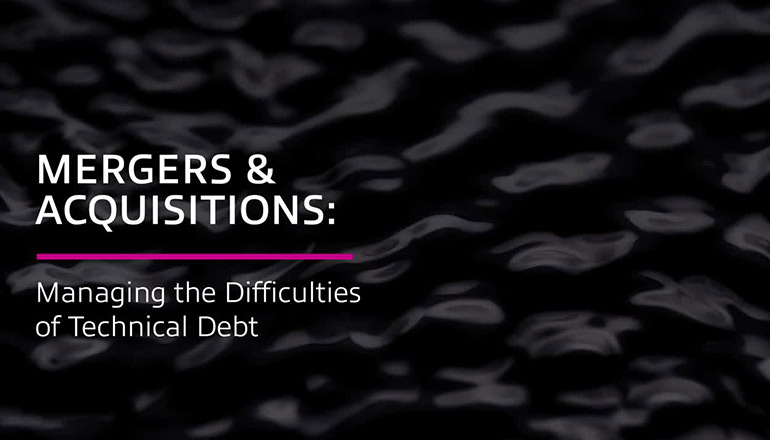Blog Unleash Innovation: How to Tackle Technical Debt & Embrace AI
A look at what’s holding innovators back from pursuing the benefits of AI and digital transformation — and how to get ahead.
By Scott Cameron / 4 Jun 2024 / Topics: Artificial Intelligence (AI) Modern infrastructure Cloud Digital transformation

Artificial Intelligence (AI) has opened a new frontier for organizations to use in creating innovative experiences for clients while driving efficiency through automation. The road to the future isn’t well paved for many organizations, however. In many cases, technical debt — older systems, software, and processes — hinders successful AI adoption and digital transformation.
If the 2010s were the decade of cloud, the 2020s are shaping up to be the decade of data and AI innovation. Unfortunately for many organizations, the cloud has caused IT disruption and uncertainty.
Where to place IT workloads is often a pendulum swinging between traditional data centers and public clouds like AWS, Azure and GCP. Initial excitement about the value and capabilities of public clouds was certainly warranted, but execution of digital transformations has been inconsistent.
Challenges with the cloud have included:
- Insufficient IT team upskilling
- Poor evaluation of workloads to determine fit for cloud migration
- Stalled re-platforming/refactoring to PaaS/SaaS and cloud-native functionality (essentially treating clouds like traditional data centers)
- Lack of proper cost analysis and budgeting for digital transformation efforts and operational costs
These challenges with cloud combined with aging IT infrastructure and software can cause delays to innovation. Frustrated leaders saddled with this kind of technical debt are often tempted to make end runs around IT groups rather than tackle the source of the problem — which causes yet more technical debt in the form of shadow IT.
Much like interest on debt, technical debt compounds and won’t resolve on its own. The result: Organizations accumulate more and more debt, slowing the momentum of innovation until it drags to a complete halt.
If organizations want to unlock the true value of their data and accelerate AI adoption, the hard work of addressing aging infrastructure — both for physical IT assets and the IT organization itself — are critical to adopting new technologies.
Where do technology leaders start?
#1: Get an inventory.
Everything begins with a full discovery of the current IT estate. Creating a plan for addressing the IT backlog requires establishing a baseline of what the organization has to work with. In many cases, I’ve found clients don’t have a complete inventory of systems and software — leading to unrealistic assumptions about what the actual lift is to get out of debt.
There are many tools for discovery. Start with your compute – for instance, for VMware clients, the answer may be as simple as exporting inventory information with the popular RVTools utility that connects to vSphere. Other platforms have similar tools and third-party software tools often deploy agents or virtual appliances to gather inventory data about compute.
Next, tackle storage and network. Storage discovery is often performed through vendor tools like NetApp’s Inventory Collect Tool (ICT) and Pure’s Pure1. Network inventory tools include Nagios XI, SolarWinds, Datadog and more.
More comprehensive asset management packages combine these capabilities with IT Service Management methodologies, and some integrate with IT management platforms like ServiceNow and Microsoft’s System Center.
#2: Evaluate your IT estate.
Once a comprehensive inventory of assets is available, the next step is to determine who owns everything. This is maybe the hardest challenge, especially in larger organizations. Finding application and server owners often results in dead ends and uncertainty. Especially with custom applications, they may be insufficiently documented, and app owners frequently leave organizations without transitioning ownership or even notifying IT.
Whether owners are found or not, the next step is to establish if systems are actually in use, and by whom. These answers are often illuminating and can lead to early wins in reducing technical debt. When performing evaluations like this, I often find systems that have been continually deployed for years but have no users.
Other things to look for:
- Current apps hosted on aging infrastructure where better platform choices are available
- Multiple, competing software packages and multiple deployed versions of the same applications
- End-of-service penalties, ending warranties or support services, expiring contracts
One of the most important evaluations is for your Total Cost of Ownership (TCO) for systems. As they age, systems’ TCO increases and defining events like penalties and contract expirations often tip the balance against maintaining the status quo. TCO analyses should be updated on a regular basis — yearly or bi-annually at least.
#3: Address your technical debt.
The rewards for all your hard discovery and evaluation work are in putting a dent in your debt. Your assessments should reveal opportunities to invest in new technologies while reducing reliance on aging systems and software. Your next step is to make your remediation plan and act on it.
As you start tackling your plan, if you’re like many of Insight’s clients, you’ll find systems and apps that can be quickly retired — releasing resources back to IT and the organization— and resulting in early wins that help create momentum with both management and IT staff. Next, concentrate on consolidating to supported platforms without refactoring applications.
The more debt you can retire this way, the more you can focus on your bigger challenges: hardware that needs replacing, software that needs patching or upgrading, and out-of-date processes and procedures that need updating.
It may help to identify change champions and gamify your initiatives. Change champions create excitement and help invest your teams in change. They act as community advocates both for management to the greater team as well as for the teams back to management.
Gamifying your initiative could mean creating milestones at which your teams are rewarded for progress or putting out bounties and rewards for finding and decommissioning rogue systems or stamping out shadow IT accounts and software.
#4: Stay out of technical debt.
You’ve done the hard work to tackle your debt — now what? You are now much better positioned to innovate and deploy new services and solutions like AI and start creating net-new value. But how do you stay out of debt so that in a year or two, you don’t just end up right back where you started?
Rigor, structure, methodologies and process are your friends. If you don’t adhere to ITIL or ITSM, COBIT, TOGAF, DevOps, etc. — you’re probably due for a reevaluation of your IT strategy. It’s not just a question of IT strategy, but also organizational strategy in how IT resources are consumed and whether IT is considered a partner to the organization (or simply overhead and operating costs).
IT can be an important partner in creating value — enabling innovation, helping differentiate against competition, improving the employee experience and much more. When organizations adopt a partnership mentality with IT, investment in not just the hardware and software but also in the health of the IT organization comes naturally. Good leadership is critical in developing this kind of relationship with the organization.
To stay out of debt, here are some activities to consider:
- Update your asset management with recent inventory information regularly (monthly or quarterly at least). It would be even better to implement a real-time inventory and IT governance system.
- Make sure your change management matches the platforms you support. Legacy CM designed around physical infrastructure with three to five-year lifecycles is insufficient for managing virtual infrastructure like public clouds, where systems can be deployed and decommissioned in minutes or hours from code (Infrastructure as Code).
- Use tagging and automation with policy to ensure that application and hardware owners are properly identified and kept up to date.
- Implement cost-management systems or tools that evaluate TCO and tie back to budgets so that costs stay in line with expectations.
- Reevaluate platforms, their capabilities and use cases on a regular basis. The calculations around investment in a hardware or software platform or data center versus public cloud may change over time as new capabilities and pricing emerge.
- Consider aligning IT investments to organization goals more often. This may mean changing the three to five-year IT renewal strategies many organizations have that are dictated by Capital Expenditure (CapEx) depreciation schedules. This is where public cloud investments get interesting.
I consider technical debt to be a self-inflicted wound — but one that is preventable and manageable with the proper preparation, tools and investments. The rewards to addressing debt are many, not the least of which is that you won’t have to deal with the headaches aging systems present.
I think the best reward, though, is seeing innovation take off with new technologies like AI — and carving out competitive differentiation in your industry.




